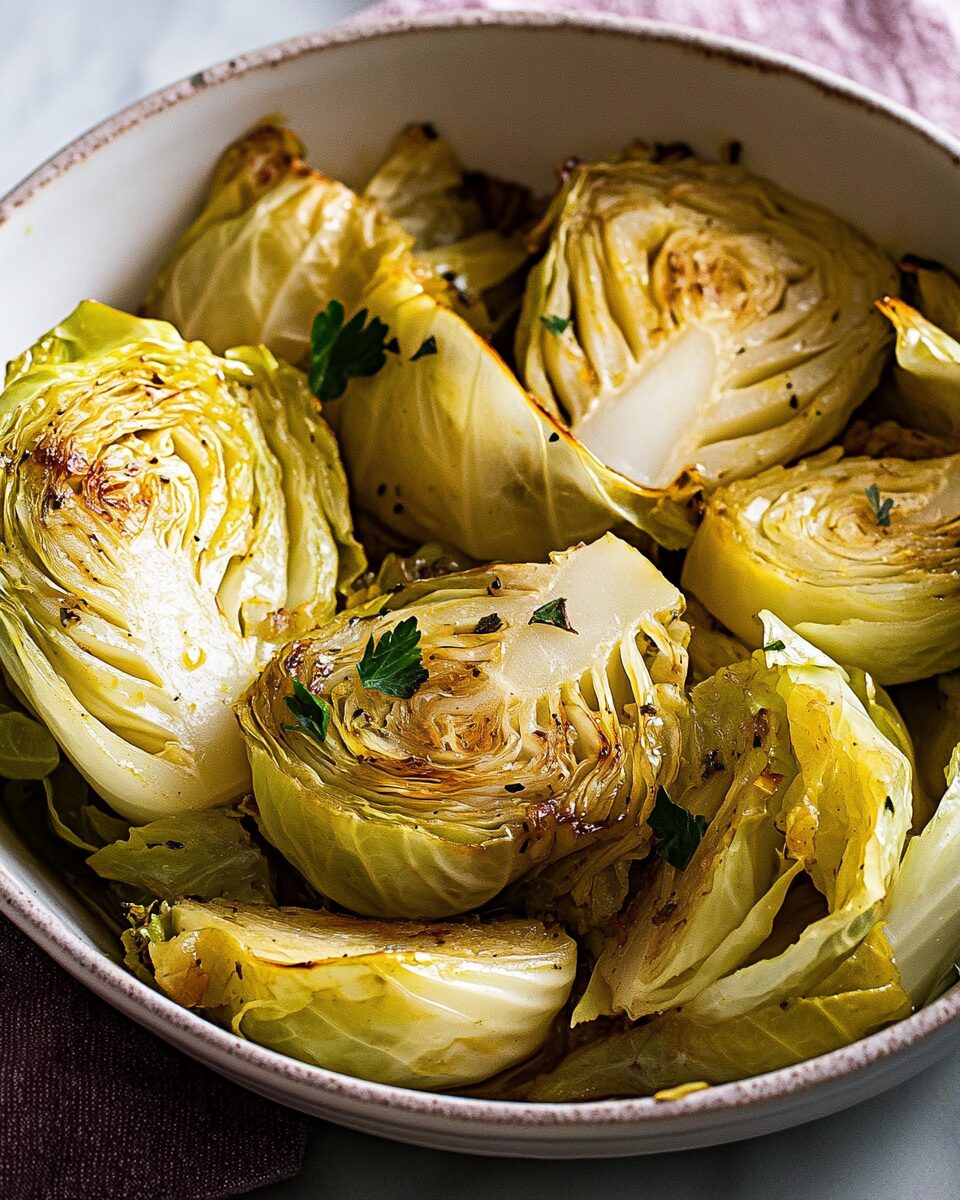Melting cabbage is the ultimate transformation dish — turning the sturdy crunch of cabbage into a silky, fork-tender delight. Searing the cabbage first creates caramelized edges, while slow braising it in white wine and broth infuses deep flavor. This is comfort food with a chef’s twist.
This dish pairs beautifully with just about anything — roasted meats, vegetarian mains, or served on its own with crusty bread to soak up all that savory broth. A touch of lemon and butter at the end adds brightness and richness. Whether for a holiday spread or weeknight dinner, melting cabbage will be your new go-to veggie star.
Full Recipe:
2 to 3 tablespoons olive oil
1 medium head green or red cabbage (about 1 1/2 pounds), cut into 8 wedges with core intact
1 medium yellow onion, thinly sliced
3 cloves garlic, minced
1/2 cup dry white wine
1 to 2 cups chicken or vegetable stock
1 teaspoon kosher salt
1/2 teaspoon freshly ground black pepper
1 bay leaf (optional)
Juice from 1/2 lemon
2 tablespoons unsalted butter (optional)
Fresh chopped parsley or dill, for garnish (optional)
Directions:
Preheat the oven to 375°F (190°C).
Heat olive oil in a large cast iron skillet over medium heat. Add cabbage wedges cut side down, pressing gently. Sear for 3–7 minutes until dark golden brown, then flip and repeat on the other side. Remove to a plate.
If the pan is dry, add a bit more olive oil. Sauté onions for about 5 minutes until golden. Add garlic and cook another 1–2 minutes until fragrant.
Return the cabbage to the skillet, arranging it in a single layer or as close as possible. Pour in the wine and simmer for 1–2 minutes until the alcohol cooks off.
Add enough broth to come halfway up the sides of the cabbage. Sprinkle in salt and pepper. Add bay leaf if using.
Transfer the skillet to the oven and bake for 35–45 minutes, or until the cabbage is fork-tender.
Finish with a splash of lemon juice and stir in butter and fresh herbs if desired. Serve warm.
Prep Time: 10 minutes | Cooking Time: 45 minutes | Total Time: 55 minutes
Kcal: 117 kcal | Servings: 4 to 6 servings
A Celebration of Simplicity: The Magic Behind Melting Cabbage
There are few dishes that offer the same surprising depth of flavor, texture, and satisfaction as melting cabbage. Often underestimated, cabbage is a humble vegetable with endless potential. This recipe — slowly braised cabbage in white wine and broth, finished with lemon and optional butter — elevates it from basic to breathtaking. Melting cabbage is more than just a side dish; it’s a statement about how thoughtful preparation can transform even the simplest ingredients into something extraordinary.
Why This Recipe Works So Well
At first glance, cabbage may seem too mundane to deserve its own spotlight. But when treated properly — seared to develop a caramelized crust and then slowly braised — its flavor becomes rich, mellow, and nuanced. The natural sugars in cabbage caramelize beautifully, while the braising process softens the fibrous leaves into a buttery, melt-in-your-mouth texture.
This technique, often called “melting” cabbage, is a classic in many cultures. The French have their chou braisé, Eastern Europeans bake or stew cabbage regularly, and even in southern American kitchens, slow-cooked greens are a staple. This recipe draws inspiration from those traditions while keeping things streamlined for the modern home cook.
The key here is balance: acidity from white wine, umami and depth from chicken or vegetable stock, a bit of brightness from lemon, and the richness of optional butter to finish. Together, these elements create a dish that feels comforting and elevated at the same time.
The Science of Braising Cabbage
Cabbage is part of the brassica family — the same group that includes broccoli, kale, and Brussels sprouts. While raw cabbage has a pungent, peppery flavor and crunchy texture, heat radically transforms it. When braised, cabbage’s natural bitterness fades, giving way to its underlying sweetness.
The Maillard reaction, which occurs during the searing stage, creates a depth of flavor by browning the surface of the cabbage. This isn’t just about color — those browned bits are flavor gold. Once the wine and broth are added, the braising liquid gently cooks the cabbage through a combination of moist and dry heat. Over time, the liquid reduces, intensifying in flavor, and infusing the cabbage wedges with savory richness.
Another reason this recipe works so well is because the cabbage is cut into wedges but kept attached to the core. This technique helps the cabbage hold its shape throughout the cooking process while allowing each wedge to absorb flavor uniformly.
Pairing Suggestions and Serving Ideas
Melting cabbage is incredibly versatile. Its savory profile and soft texture make it a perfect partner for many proteins and grains. Here are a few great ways to enjoy it:
Roast Chicken or Pork Chops: The buttery, wine-infused cabbage complements the savory umami of roasted or pan-seared meats.
Pierogi or Dumplings: Serve it alongside Eastern European dumplings for a hearty, rustic meal.
Polenta or Mashed Potatoes: The braising liquid doubles as a sauce, so it’s ideal over creamy starches.
As a Topping: Pile it high on a thick slice of toasted sourdough or atop a grain bowl for a plant-forward lunch or dinner.
With Sausages: Pan-seared or grilled sausages pair beautifully with the sweet-sour nature of the cabbage.
Make it a Main: Add chickpeas, white beans, or lentils to the braising liquid to boost the protein content and make this dish the centerpiece.
What sets melting cabbage apart is that it truly enhances the dishes it’s served with — it doesn’t just sit on the plate as an afterthought.
Nutritional Highlights and Health Benefits
Cabbage is a nutritional powerhouse, offering numerous health benefits for very few calories. It’s high in vitamin C, vitamin K, and fiber, while also containing beneficial antioxidants and anti-inflammatory compounds.
The slow braising method used in this recipe helps preserve many of these nutrients. While boiling can sometimes leach water-soluble vitamins into the cooking liquid, this recipe retains much of the nutrition in the pan. If you use vegetable broth, the dish remains vegetarian and still delivers plenty of savory satisfaction.
Here are some notable health benefits of cabbage:
Digestive Support: Thanks to its fiber content, cabbage aids in digestion and promotes regularity.
Anti-inflammatory: Compounds like sulforaphane and anthocyanins (especially in red cabbage) can help reduce inflammation.
Heart Health: Cabbage’s potassium content supports healthy blood pressure levels.
Immunity Boosting: Vitamin C and antioxidants strengthen the immune system and support healing.
Low-Calorie but Filling: With only about 117 calories per serving, this dish is incredibly satisfying without being heavy.
Adding olive oil and optional butter provides healthy fats that help with the absorption of fat-soluble vitamins, while also enhancing mouthfeel and flavor.
Tips and Tricks for Success
Though the recipe is straightforward, a few tips can ensure success every time:
Use a cast iron or heavy-bottomed skillet: It holds heat well and gives a nice sear.
Don’t rush the browning: This is where flavor development happens. Let the cabbage get deeply golden on each side before moving on.
Deglaze properly: When adding wine, scrape up all the brown bits from the bottom of the pan — that’s concentrated flavor.
Control the liquid level: The broth should only come halfway up the sides of the cabbage. Too much liquid will steam rather than braise.
Add finishing touches after baking: A squeeze of lemon brightens the dish, and butter enriches it further. Don’t skip this if you want the full experience.
Variations to Explore
The base of this recipe is highly adaptable. Once you’ve mastered the technique, try these creative variations:
Add a smoky element: Use smoked paprika or even a few dashes of liquid smoke.
Make it spicy: Add chili flakes or thinly sliced jalapeños.
Switch the wine: Swap white wine for dry vermouth or a splash of apple cider vinegar for an alcohol-free option.
Layer in more vegetables: Carrots, parsnips, or fennel slices add texture and sweetness.
Top with breadcrumbs: Toasted breadcrumbs or grated Parmesan add a crunchy, savory contrast.
Make it vegan: Use vegetable stock and olive oil throughout, and skip the butter.
These twists allow the dish to evolve with the seasons and your preferences.
Storage and Reheating
Melting cabbage stores beautifully. The flavors deepen over time, making it a fantastic make-ahead option. Store it in an airtight container in the refrigerator for up to five days. Reheat gently on the stovetop or in the microwave, adding a splash of broth if it’s become too thick.
Leftovers can be chopped and added to soups, stews, or even scrambled eggs. It also makes a great filling for savory crepes or wraps.
Conclusion: The Humble Cabbage, Reimagined
Melting cabbage proves that you don’t need fancy ingredients or complicated methods to create something deeply satisfying. With just a few pantry staples and some patience, you can turn a basic vegetable into a dish that feels gourmet and comforting all at once. It’s the kind of recipe that makes you slow down and savor each bite — a true celebration of everyday cooking.
Whether you’re serving it at a cozy family dinner, adding it to your holiday table, or simply enjoying a






